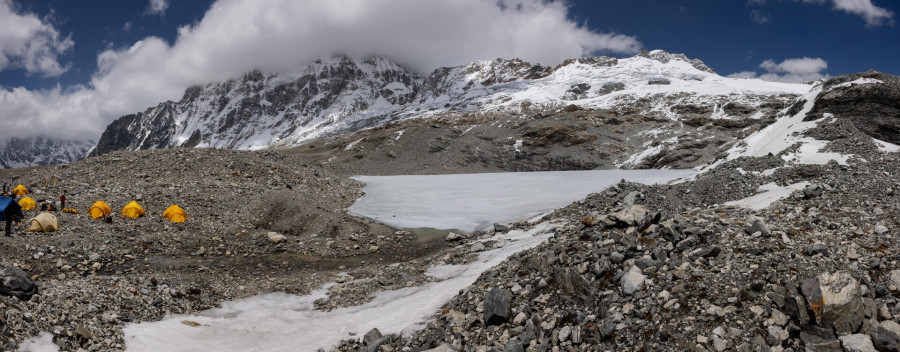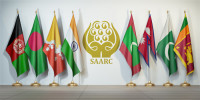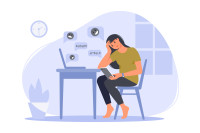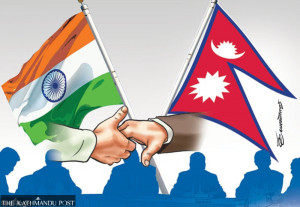Columns
Requiem for a glacier
A glacier is disappearing in the Himalayas, leaving mounds of debris and a warning too dire to ignore.
Arun Shrestha & Qianggong Zhang
Just days before climate leaders, scientists and policymakers gather in Kathmandu for Sagarmatha Sambaad, Nepal’s first global dialogue on climate and environment, a small team of researchers from ICIMOD, the Department of Hydrology and Meteorology, Kathmandu University and Tribhuvan University made a different kind of journey. They hiked to the base of Yala Glacier, in the Langtang region, to pay tribute to a glacier that has been a living laboratory for generations of scientists. They were joined by members of communities from Langtang and Kyanjin, who stand to lose a part of their natural heritage.
Yala Glacier, one of the most studied glaciers in the central Himalaya, has lost nearly 66 percent of its surface area since it was first systematically monitored by Japanese scientists in the 1970s. This glacier tells the story of our changing planet, which is unfolding faster than we ever imagined.
Since its initial monitoring in 1974, Yala Glacier has steadily declined. Different methods, including field-based mass balance measurements, geodetic surveys and satellite imagery, all confirm the same alarming trend: The glacier is retreating, thinning and losing mass at an unprecedented pace. These changes are not just numbers on a graph, each data point is a warning sign of the profound impact of rapid warming on high mountain ecosystems. Glaciers like Yala are bellwethers of the cryosphere’s retreat in the face of climate change.
Why this matters
In 2015, when nations convened in Paris, they agreed, morally if not legally, to limit global warming to 1.5 degrees Celsius above pre-industrial levels. They did so with full knowledge that overshooting this threshold would lead to catastrophic consequences. Today, however, that threshold has been temporarily breached several times. Projections suggest that we are clearly on a trajectory to surpass 2 degrees Celsius.
Recent assessments, including ICIMOD’s HIWISE report 2023, show that the region is warming nearly twice the global average. This accelerated warming is having severe, visible effects on the region’s cryosphere. Glaciers in our region are thinning, losing mass and retreating at rates unprecedented in recorded history. While natural climate variability can impact the cryosphere, the velocity and scale of today's transformations are clearly driven by human-induced climate change. What once unfolded over millennia is now happening within a few decades.
Glaciers are essential sources of freshwater, and their decline threatens the livelihoods of communities who rely on seasonal meltwater for drinking, agriculture and hydropower. Yala Glacier’s retreat is akin to a canary in the coal mine, warning us of a much larger, systemic problem.
What are we doing
All is not yet lost. Since 2015, momentum for climate action has grown and, in our region, scientific efforts have shifted from sporadic glacier surveys to sustained, long-term monitoring programmes, thanks to funding from the governments of Norway, Sweden and Switzerland. Advances in remote sensing, uncrewed aerial vehicle (UAV) technology and harmonised field measurements are producing a deeper understanding of the impacts of climate change on our high-altitude hydrology and ecosystems.
Regional cooperation is also gaining traction. Countries in the region increasingly recognise the value of harmonised data collection, which enables the development of more robust regional climate models and more effective risk assessments. ICIMOD’s work on identifying potentially dangerous glacial lakes in Nepal and promoting multi-hazard risk management frameworks demonstrates that more science-driven action is not only urgently needed, but also achievable.
A better understanding of current and potential future cryosphere changes and stronger regional collaboration provide a solid foundation for effectively conveying these issues in global forums. By amplifying our message in international spaces, we can pressure global actors to take urgent, decisive action.
What next
Though we may not have yet succeeded in containing the rise in global temperature, the willingness of countries in this region to collaborate on mountain science and climate risk management offers hope. This cooperation forms the foundation upon which we can build stronger climate frameworks. The tribute to Yala Glacier is not only a farewell but a reminder that the glacier is not just a casualty of climate change, but a symbol of the broader challenges we face. It is a clarion call to intensify climate action, a plea for continued investment in mountain science and a commitment to ensuring that the momentum we have gained is never lost. The rapid retreat of glaciers like Yala is happening now, and the window for meaningful action is closing faster than we think. We must act now, or we risk losing the cryosphere and the livelihoods of millions that depend on it.
As Sagarmatha Sambaad 2025 convenes under the theme of Climate Change, Mountains and the Future of Humanity, the story of Yala Glacier provides a sobering case study for the region’s cryosphere. The dialogue must acknowledge these changes and inspire collective action grounded in science, shaped by collaboration and driven by urgency.




 16.12°C Kathmandu
16.12°C Kathmandu
















